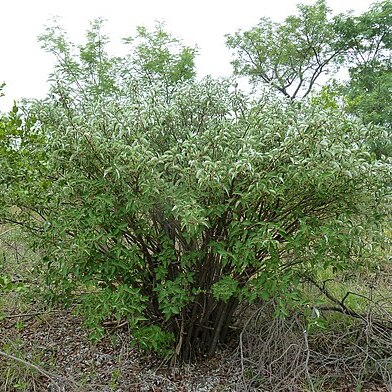Shrub or small tree up to 3(-5) m high. Stems longitudinally striate, greyish or reddish brown, with wide spongy pith or hollow centre, wood soft, inflorescence and leaf scars prominent especially on young stems, with dense curved or arachnoid hairs when young, glabrescent. Leaves deciduous, ovate to lanceolate, 48-115 x 25-75 mm, apex attenuate-acute, base cuneate to truncate, upper surface roughly velvety or scabrid, with dense hairs, lower surface densely to slightly white-felted, felt sparse on veins; petiole 15-22 mm long, pubescent to white-felted; stipules ovate to lanceolate, membranous, red-brown, apex acute to acuminate, midrib pronounced, hairs scattered or restricted to midrib and margin. Inflorescence appearing with young leaves, sessile in leaf axils or scattered along twigs. Female flowers sessile, pubescent, 2-3 mm long. Male flowers pedicellate, pubescent, 1.5-2.5 mm long. Achenes ± compressed fusiform, smooth, shiny, dark brown, ±2.5 mm long, sometimes dispersed with persisting membranaceous perianth.
A shrub. It can be 4 m high The stems are slender. The bark is dark purple-brown and smooth. The leaves are alternate. They are 10 cm long by 5 cm wide. There are no teeth along the edge. The leaves taper to the tip. The upper surface is green and the lower surface is covered with white felt. The flowers are in dense round clusters. These are 1 cm across.
Stems of soft wood with a spongy pith or hollow centre, branchlets thick, more than 1.5 mm. in diam.; bark longitudinally striate, greyish or reddish-brown, leaf and inflorescence scars prominent; indumentum on young parts white-arachnoid, later glabrescent.
Female flowers few, sessile; perianth 1.5–2 mm. long, ovoid, fused almost to the apex and completely enclosing the ovary, with 3–8 longitudinal ridges of which 2 are usually larger than the others; stigma 2–4 mm. long, filiform, exserted.
Leaves deciduous, 2–6(10) x 1–3(7) cm., ovate; apex acuminate; base obliquely cuneate or rounded; margin entire; upper surface of lamina ± scabridulous with scattered stiff hairs, lower surface with a ± densely white arachnoid tomentum.
Inflorescences bisexual, in dense axillary clusters, appearing with young leaves, sessile in axils of current leaves or scattered along twigs in axils of fallen leaves; bracts short, linear.
Shrub or tree, up to 5 m high. Leaves entire, usually densely greyish white-felted below, dark green above. Anthers white. Flowers (perianth) greenish yellow.
Male flowers numerous, on pedicels c. 1 mm. long; perianth c. 1 mm. in diam., (4)5-merous.
Achene c. 2 mm. long, brownish, smooth, enclosed in the persistent perianth.
Stipules up to 5 mm. long, lanceolate, puberulous, ciliate.
Petiole 0.8–1.5(2) cm. long.
Shrubs to 3(5) m. tall.


